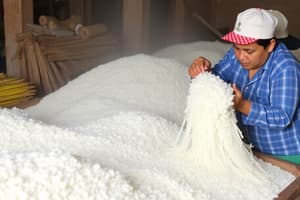Podcast
Questions and Answers
What is the purpose of the shredding process in the sugar cane processing?
What is the purpose of the shredding process in the sugar cane processing?
Which process immediately follows milling in the sugar cane processing?
Which process immediately follows milling in the sugar cane processing?
What is the purpose of the gravitational settling tank in the clarification process?
What is the purpose of the gravitational settling tank in the clarification process?
How is the syrup concentrated after clarification?
How is the syrup concentrated after clarification?
Signup and view all the answers
What happens to the syrup during the crystallization process?
What happens to the syrup during the crystallization process?
Signup and view all the answers
What is bagasse in the sugar processing context?
What is bagasse in the sugar processing context?
Signup and view all the answers
In which part of the process does the syrup begin to form sugar crystals?
In which part of the process does the syrup begin to form sugar crystals?
Signup and view all the answers
What is the final step in the sugar cane processing before it is stored?
What is the final step in the sugar cane processing before it is stored?
Signup and view all the answers
Study Notes
Sugar Cane Processing
- Stages: Sugar cane processing involves entry/transport, milling, clarification, evaporation, crystallization, separation, refining, drying, and storage.
Entry/Transportation
- Sugar cane is processed at mills near production centers.
- Cane is washed, cut into small pieces by revolving knives, and then shredded into fibrous material.
- Shredding ruptures sugar-containing cells, but no juice is extracted at this stage.
- After shredding, juice extraction is possible.
Milling Train
- Shredded cane is fed to crushers to extract sugar-rich juice.
- Crushers are comprised of two large, horizontally mounted grooved rollers (one above the other), with high hydraulic pressure applied to the upper roller.
- The remaining fibre is bagasse.
- Juice is pumped for further processing.
Clarification and Evaporation
- Clarification: Lime juice enters a settling Clarifier tank.
- Slow juice flow allows solids to settle, resulting in clear juice being released.
- Solids from clarifier (mud) contain valuable sugar.
- Mud is filtered using rotary vacuum filters for residual juice extraction.
- Mud is washed producing a sweet water, which is recycled.
- Evaporation: Clarified juice is concentrated into syrup by boiling off water in connected vessels.
- Evaporators operate under decreasing pressure, eventually reaching a vacuum.
- Syrup from evaporators undergoes further concentration in vacuum pans.
- Seed crystals are added to the syrup, causing crystal growth.
- Once crystals reach required size, the mixture is discharged from the pan.
Crystallization
- Sugar crystals are separated from syrup using centrifugal machines.
- Moist raw sugar is air-dried and stored.
- Separated syrup is reboiled for further crystal growth.
- After three boilings, no more sugar can be economically recovered, resulting in molasses.
Separation
- Sugar crystals are separated from syrup to obtain raw sugar.
- Raw sugar is air-dried and stored in bulk storage bins, producing raw sugar.
Sugar Refining
- Refinery removes impurities from sugar crystals.
- Raw sugar is dissolved and decolorized using various clarification processes.
- Brown/raw sugar is melted, decolorized using carbon filters, recrystallized in vacuum pans, and dried by centrifuging.
Studying That Suits You
Use AI to generate personalized quizzes and flashcards to suit your learning preferences.
Description
This quiz covers the stages of sugar cane processing, including entry, milling, clarification, evaporation, and crystallization. Understand how sugar is extracted and refined through various processes. Ideal for those studying agricultural science or food technology.




